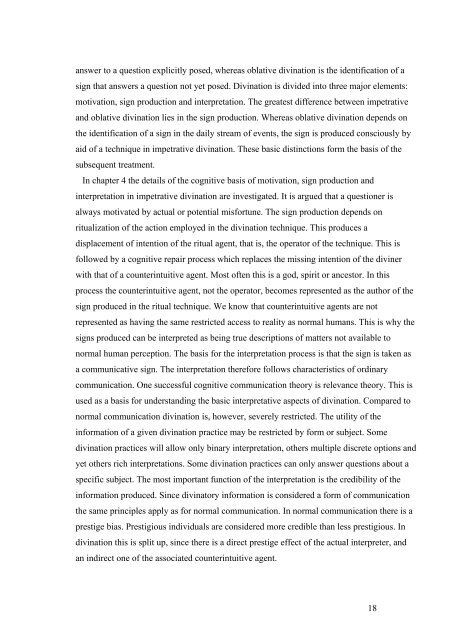The dissemination of divination in roman republican times
The dissemination of divination in roman republican times
The dissemination of divination in roman republican times
Create successful ePaper yourself
Turn your PDF publications into a flip-book with our unique Google optimized e-Paper software.
answer to a question explicitly posed, whereas oblative <strong>div<strong>in</strong>ation</strong> is the identification <strong>of</strong> a<br />
sign that answers a question not yet posed. Div<strong>in</strong>ation is divided <strong>in</strong>to three major elements:<br />
motivation, sign production and <strong>in</strong>terpretation. <strong>The</strong> greatest difference between impetrative<br />
and oblative <strong>div<strong>in</strong>ation</strong> lies <strong>in</strong> the sign production. Whereas oblative <strong>div<strong>in</strong>ation</strong> depends on<br />
the identification <strong>of</strong> a sign <strong>in</strong> the daily stream <strong>of</strong> events, the sign is produced consciously by<br />
aid <strong>of</strong> a technique <strong>in</strong> impetrative <strong>div<strong>in</strong>ation</strong>. <strong>The</strong>se basic dist<strong>in</strong>ctions form the basis <strong>of</strong> the<br />
subsequent treatment.<br />
In chapter 4 the details <strong>of</strong> the cognitive basis <strong>of</strong> motivation, sign production and<br />
<strong>in</strong>terpretation <strong>in</strong> impetrative <strong>div<strong>in</strong>ation</strong> are <strong>in</strong>vestigated. It is argued that a questioner is<br />
always motivated by actual or potential misfortune. <strong>The</strong> sign production depends on<br />
ritualization <strong>of</strong> the action employed <strong>in</strong> the <strong>div<strong>in</strong>ation</strong> technique. This produces a<br />
displacement <strong>of</strong> <strong>in</strong>tention <strong>of</strong> the ritual agent, that is, the operator <strong>of</strong> the technique. This is<br />
followed by a cognitive repair process which replaces the miss<strong>in</strong>g <strong>in</strong>tention <strong>of</strong> the div<strong>in</strong>er<br />
with that <strong>of</strong> a counter<strong>in</strong>tuitive agent. Most <strong>of</strong>ten this is a god, spirit or ancestor. In this<br />
process the counter<strong>in</strong>tuitive agent, not the operator, becomes represented as the author <strong>of</strong> the<br />
sign produced <strong>in</strong> the ritual technique. We know that counter<strong>in</strong>tuitive agents are not<br />
represented as hav<strong>in</strong>g the same restricted access to reality as normal humans. This is why the<br />
signs produced can be <strong>in</strong>terpreted as be<strong>in</strong>g true descriptions <strong>of</strong> matters not available to<br />
normal human perception. <strong>The</strong> basis for the <strong>in</strong>terpretation process is that the sign is taken as<br />
a communicative sign. <strong>The</strong> <strong>in</strong>terpretation therefore follows characteristics <strong>of</strong> ord<strong>in</strong>ary<br />
communication. One successful cognitive communication theory is relevance theory. This is<br />
used as a basis for understand<strong>in</strong>g the basic <strong>in</strong>terpretative aspects <strong>of</strong> <strong>div<strong>in</strong>ation</strong>. Compared to<br />
normal communication <strong>div<strong>in</strong>ation</strong> is, however, severely restricted. <strong>The</strong> utility <strong>of</strong> the<br />
<strong>in</strong>formation <strong>of</strong> a given <strong>div<strong>in</strong>ation</strong> practice may be restricted by form or subject. Some<br />
<strong>div<strong>in</strong>ation</strong> practices will allow only b<strong>in</strong>ary <strong>in</strong>terpretation, others multiple discrete options and<br />
yet others rich <strong>in</strong>terpretations. Some <strong>div<strong>in</strong>ation</strong> practices can only answer questions about a<br />
specific subject. <strong>The</strong> most important function <strong>of</strong> the <strong>in</strong>terpretation is the credibility <strong>of</strong> the<br />
<strong>in</strong>formation produced. S<strong>in</strong>ce div<strong>in</strong>atory <strong>in</strong>formation is considered a form <strong>of</strong> communication<br />
the same pr<strong>in</strong>ciples apply as for normal communication. In normal communication there is a<br />
prestige bias. Prestigious <strong>in</strong>dividuals are considered more credible than less prestigious. In<br />
<strong>div<strong>in</strong>ation</strong> this is split up, s<strong>in</strong>ce there is a direct prestige effect <strong>of</strong> the actual <strong>in</strong>terpreter, and<br />
an <strong>in</strong>direct one <strong>of</strong> the associated counter<strong>in</strong>tuitive agent.<br />
18


